Casimir Effect in MEMS: Materials, Geometries, and Metrologies—A Review
Abstract
1. Introduction
2. Survey about Experimental and Theoretical Studies of Casimir Forces
2.1. Plate–Plate Geometries with Different Material Combinations
2.2. Lens/Sphere–Plate and Sphere–Sphere Geometries with Different Material Combinations
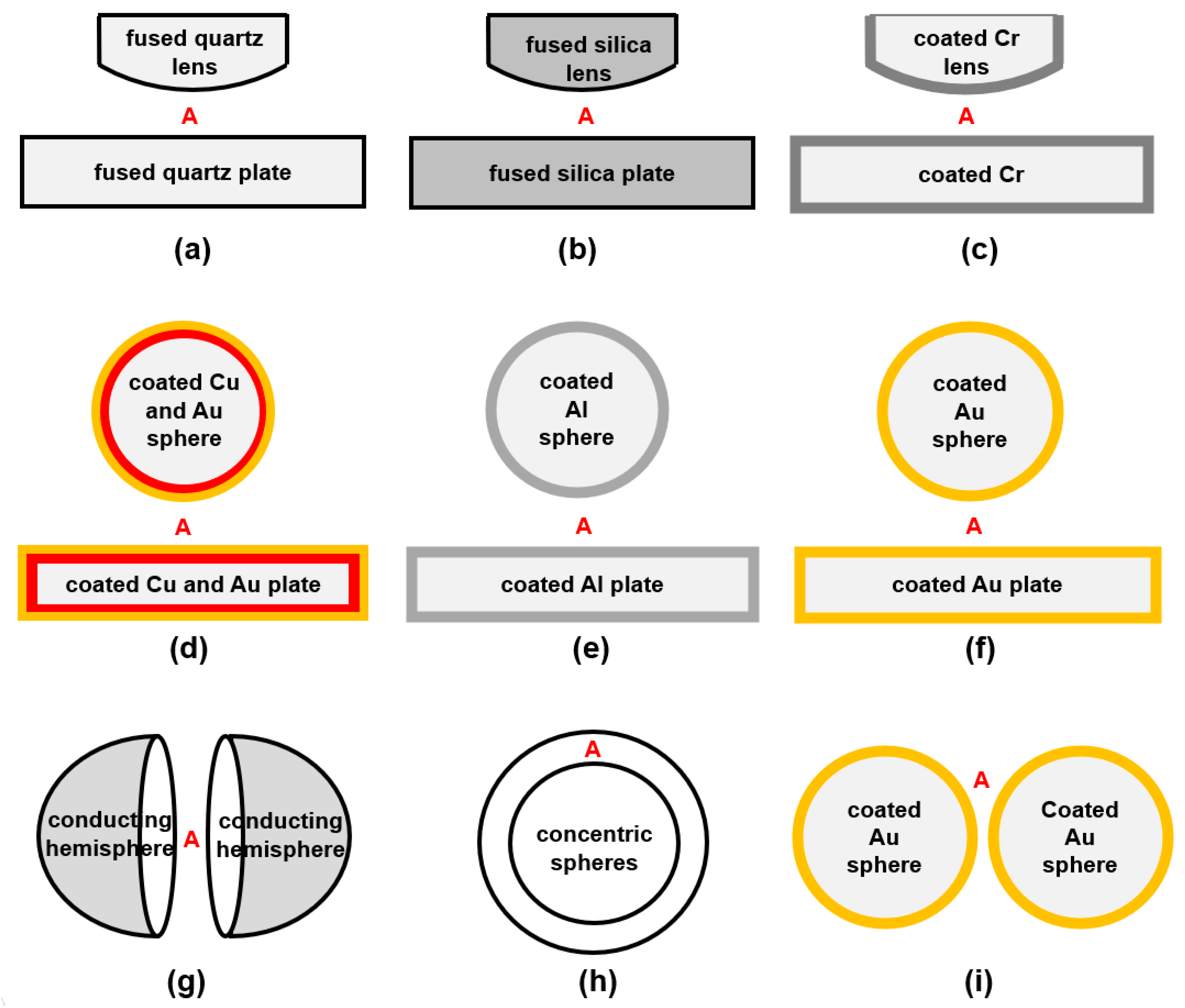
2.3. Cylinder–Cylinder/Plate/Sphere Geometries with Different Material Combinations
2.4. Special Geometries with Different Material Combinations
3. Main Measurement Methods: Review of Casimir Metrology
4. Influence of Further Parameters on Casimir Forces
4.1. Influence of Thermal Effects
4.2. Influence of Conductivity Effects
4.3. Influence of Surface Roughness
5. Influences of Casimir Forces on the Characteristics of MEMS/NEMS Devices
5.1. Influences of Casimir Forces on Stiction and Adhesion
5.2. Influences of Casimir Forces on Pull-in Voltages
5.3. Influences of Casimir Forces on Vibrational Properties
5.4. Influences of Casimir Forces on Chaotic Motion
6. Applications of Casimir Forces in MEMS/NEMS Field
6.1. Highly Sensitive Sensors
6.2. Non-Contact Actuators
6.3. Stiction-Related Applications
6.4. Heat Transfer Devices and Actuators
6.5. Optical Applications
6.6. Harvesting Devices
6.7. Applications in Quantum Computation and Communication
6.8. The Role of Machine Learning
7. Self-Assembling Structures
Three-Dimensional Self-Assembly into Yin–Yang Structures
- Dimensions A = 400 µm × 14 µm = 5600 µm2.
- Mass per unit area: = 0.62 g/m2 considering the Al-Cr-Al metal stack.
- potential difference: mV (due to charge fluctuations based on deviations in the working function of the facing aluminium surfaces).
- Contact angle: ≈ 20° (for isopropanol on hydrophilic aluminium).
- Surface tension: = 17 mN/m (for isopropanol at 68.5 °C) [176].
- Hamaker constant: (for aluminium) [64].
- 1.
- Gravitational force per unit area:
- 2.
- Electrostatic force per unit area:
- 3.
- Capillary force per unit area:
- 4.
- Casimir force per unit area in retarded limit (original formula of H. B. G. Casimir):
- 5.
- Casimir force per unit area in non-retarded limit (based on VdW interaction):
8. Summary and Conclusions
Author Contributions
Funding
Institutional Review Board Statement
Informed Consent Statement
Data Availability Statement
Acknowledgments
Conflicts of Interest
References
- Casimir, H.B.G. On the attraction between two perfectly conducting plates. Proc. Kon. Ned. Akad. Wet. 1948, 51, 793–796. [Google Scholar]
- Casimir, H.B.G.; Polder, D. The Influence of Retardation on the London-van der Waals Forces. Phys. Rev. 1948, 73, 360–372. [Google Scholar] [CrossRef]
- Israelachvili, J.N.; Tabor, D. The measurement of van der Waals dispersion forces in the range 1.5 to 130 nm. Proc. R. Soc. Lond. A Math. Phys. Sci. 1972, 331, 19–38. [Google Scholar] [CrossRef]
- Palasantzas, G.; van Zwol, P.J.; De Hosson, J.T.M. Transition from Casimir to van der Waals force between macroscopic bodies. Appl. Phys. Lett. 2008, 93, 121912. [Google Scholar] [CrossRef]
- Boström, M.; Sernelius, B.E.; Brevik, I.; Ninham, B.W. Retardation turns the van der Waals attraction into a Casimir repulsion as close as 3 nm. Phys. Rev. A 2012, 85, 010701. [Google Scholar] [CrossRef]
- Buhmann, S.Y. Dispersion Forces I: Macroscopic Quantum Electrodynamics and Ground-State Casimir, Casimir–Polder and van der Waals Forces; Springer: Berlin/Heidelberg, Germany, 2013; Volume 247. [Google Scholar]
- Buhmann, S.Y. Dispersion Forces II: Many-Body Effects, Excited Atoms, Finite Temperature and Quantum Friction; Springer: Berlin/Heidelberg, Germany, 2013; Volume 248. [Google Scholar]
- Lifshitz, E.M.; Hamermesh, M. The theory of molecular attractive forces between solids. In Perspectives in Theoretical Physics; Pergamon: Oxford, UK, 1992; pp. 329–349. [Google Scholar]
- Błocki, J.; Randrup, J.; Świa̧tecki, W.J.; Tsang, C.F. Proximity forces. Ann. Phys. 1977, 105, 427–462. [Google Scholar] [CrossRef]
- Langbein, D. Van der Waals attraction in and between solids. In Festkörperprobleme 13: Plenary Lectures of the Divisions “Semiconductor Physics”, “Surface Physics”, “Low Temperature Physics”, “High Polymers”, “Thermodynamics and Statistical Mechanics” of the German Physical Society Münster, 19–24 March, 1973; Queisser, H.J., Ed.; Springer: Berlin/Heidelberg, Germany, 1973; pp. 85–109. [Google Scholar]
- Plunien, G.; Müller, B.; Greiner, W. The Casimir effect. Phys. Rep. 1986, 134, 87–193. [Google Scholar] [CrossRef]
- Krech, M. The Casimir Effect in Critical Systems; World Scientific: Singapore, 1994. [Google Scholar]
- Mostepanenko, V.M.; Trunov, N.N. The Casimir Effect and Its Applications; Oxford University Press: Oxford, UK, 1997. [Google Scholar]
- Milton, K.A. State of the Quantum Vacuum, the: Casimir Physics in the 2020’s; World Scientific: Singapore, 2022. [Google Scholar]
- Bordag, M.; Klimchitskaya, G.L.; Mohideen, U.; Mostepanenko, V.M. Advances in the Casimir Effect; Oxford University Press: Oxford, UK, 2009. [Google Scholar]
- Decca, R.; Aksyuk, V.; López, D. Casimir Force in Micro and Nano Electro Mechanical Systems. In Casimir Physics; Dalvit, D., Milonni, P., Roberts, D., da Rosa, F., Eds.; Springer: Berlin/Heidelberg, Germany, 2011; pp. 287–309. [Google Scholar]
- Kimball, A.M. The Casimir effect: Recent controversies and progress. J. Phys. A Math. Gen. 2004, 37, R209. [Google Scholar] [CrossRef]
- Lamoreaux, S.K. The Casimir force: Background, experiments, and applications. Rep. Prog. Phys. 2005, 68, 201. [Google Scholar] [CrossRef]
- Milton, K.A. Recent developments in the Casimir effect. J. Phys. Conf. Ser. 2009, 161, 012001. [Google Scholar] [CrossRef]
- Rodriguez, A.W.; Capasso, F.; Johnson, S.G. The Casimir effect in microstructured geometries. Nat. Photonics 2011, 5, 211–221. [Google Scholar] [CrossRef]
- Milton, K.A.; Høye, J.S.; Brevik, I. The Reality of Casimir Friction. Symmetry 2016, 8, 29. [Google Scholar] [CrossRef]
- Dodonov, V. Fifty Years of the Dynamical Casimir Effect. Physics 2020, 2, 67–104. [Google Scholar] [CrossRef]
- Woods, L.M.; Krüger, M.; Dodonov, V.V. Perspective on Some Recent and Future Developments in Casimir Interactions. Appl. Sci. 2021, 11, 293. [Google Scholar] [CrossRef]
- Lu, B.-S. The Casimir Effect in Topological Matter. Universe 2021, 7, 237. [Google Scholar] [CrossRef]
- Klimchitskaya, G.L.; Mohideen, U.; Mostepanenko, V.M. The Casimir force between real materials: Experiment and theory. Rev. Mod. Phys. 2009, 81, 1827–1885. [Google Scholar] [CrossRef]
- Klimchitskaya, G.L.; Mohideen, U.; Mostepanenko, V.M. Control of the casimir force using semiconductor test bodies. Int. J. Mod. Phys. B 2011, 25, 171–230. [Google Scholar] [CrossRef]
- Mostepanenko, V.M. Experiment, theory and the Casimir effect. J. Phys. Conf. Ser. 2009, 161, 012003. [Google Scholar] [CrossRef]
- Marachevsky, V.N.; Nelson, A.D. The Casimir force in experiments with Si gratings. In Proceedings of the 2017 Progress in Electromagnetics Research Symposium—Spring (PIERS), St. Petersburg, Russia, 22–25 May 2017; pp. 467–470. [Google Scholar]
- Chan, H.B.; Bao, Y.; Zou, J. The Casimir effect on silicon micromechanical systems: Forces due to virtual photons. In Proceedings of the 2012 International Conference on Optical MEMS and Nanophotonics, Banff, AB, Canada, 6–9 August 2012; pp. 29–30. [Google Scholar]
- Chan, H.B.; Zou, J.; Marcet, Z.; Rodriguez, A.W.; Reid, M.T.H.; McCauley, A.P.; Kravchenko, I.I.I.; Lu, T.; Bao, Y.; Johnson, S.G. The Casimir effect between micromechanical components on a silicon chip. In Proceedings of the 2014 International Conference on Optical MEMS and Nanophotonics, Glasgow, UK, 17–21 August 2014; pp. 61–62. [Google Scholar]
- Bordag, M.; Mohideen, U.; Mostepanenko, V.M. New developments in the Casimir effect. Phys. Rep. 2001, 353, 1–205. [Google Scholar] [CrossRef]
- Schwinger, J.; DeRaad, L.L.; Milton, K.A. Casimir effect in dielectrics. Ann. Phys. 1978, 115, 1–23. [Google Scholar] [CrossRef]
- Sparnaay, M.J. Measurements of attractive forces between flat plates. Physica 1958, 24, 751–764. [Google Scholar] [CrossRef]
- Boyer, T.H. Van der Waals forces and zero-point energy for dielectric and permeable materials. Phys. Rev. A 1974, 9, 2078–2084. [Google Scholar] [CrossRef]
- Kupiszewska, D.; Mostowski, J. Casimir effect for dielectric plates. Phys. Rev. A 1990, 41, 4636–4644. [Google Scholar] [CrossRef] [PubMed]
- Høye, J.S.; Brevik, I. Repulsive Casimir force. Phys. Rev. A 2018, 98, 022503. [Google Scholar] [CrossRef]
- Zhou, F.; Spruch, L. van der Waals and retardation (Casimir) interactions of an electron or an atom with multilayered walls. Phys. Rev. A 1995, 52, 297–310. [Google Scholar] [CrossRef] [PubMed]
- Tomaš, M.S. Casimir force in absorbing multilayers. Phys. Rev. A 2002, 66, 052103. [Google Scholar] [CrossRef]
- Raabe, C.; Knöll, L.; Welsch, D.-G. Three-dimensional Casimir force between absorbing multilayer dielectrics. Phys. Rev. A 2003, 68, 033810. [Google Scholar] [CrossRef]
- Esteso, V.; Carretero-Palacios, S.; Míguez, H. Optical interference effects on the Casimir-Lifshitz force in multilayer structures. Phys. Rev. A 2020, 101, 033815. [Google Scholar] [CrossRef]
- Bressi, G.; Carugno, G.; Onofrio, R.; Ruoso, G. Measurement of the Casimir force between parallel metallic surfaces. Phys. Rev. Lett. 2002, 88, 041804. [Google Scholar] [CrossRef]
- Decca, R.S.; López, D.; Fischbach, E.; Klimchitskaya, G.L.; Krause, D.E.; Mostepanenko, V.M. Tests of new physics from precise measurements of the Casimir pressure between two gold-coated plates. Phys. Rev. D 2007, 75, 077101. [Google Scholar] [CrossRef]
- Derjaguin, B.V.; Abrikosova, I.I.; Lifshitz, E.M. Direct measurement of molecular attraction between solids separated by a narrow gap. Q. Rev. Chem. Soc. 1956, 10, 295–329. [Google Scholar] [CrossRef]
- Derjaguin, B.V.; Abrikossova, I.I. Direct measurements of molecular attraction of solids. J. Phys. Chem. Solids 1957, 5, 1–10. [Google Scholar] [CrossRef]
- Rouweler, G.C.J.; Overbeek, J.T.G. Dispersion forces between fused silica objects at distances between 25 and 350 nm. Trans. Faraday Soc. 1971, 67, 2117–2121. [Google Scholar] [CrossRef]
- Van Blokland, P.H.G.M.; Overbeek, J.T.G. Dispersion forces between objects of fused silica. J. Colloid Interface Sci. 1979, 68, 96–100. [Google Scholar] [CrossRef]
- Van Blokland, P.H.G.M.; Overbeek, J.T.G. van der Waals forces between objects covered with a chromium layer. J. Chem. Soc. Faraday Trans. Phys. Chem. Condens. Phases 1978, 74, 2637–2651. [Google Scholar] [CrossRef]
- Lamoreaux, S.K. Demonstration of the Casimir Force in the 0.6 to 6 μm Range. Phys. Rev. Lett. 1997, 78, 5–8. [Google Scholar] [CrossRef]
- Mohideen, U.; Roy, A. Precision Measurement of the Casimir Force from 0.1 to 0.9 μm. Phys. Rev. Lett. 1998, 81, 4549–4552. [Google Scholar] [CrossRef]
- Roy, A.; Lin, C.Y.; Mohideen, U. Improved precision measurement of the Casimir force. Phys. Rev. D 1999, 60, 111101. [Google Scholar] [CrossRef]
- Harris, B.W.; Chen, F.; Mohideen, U. Precision measurement of the Casimir force using gold surfaces. Phys. Rev. A 2000, 62, 052109. [Google Scholar] [CrossRef]
- Decca, R.S.; Lopez, D.; Fischbach, E.; Krause, D.E. Measurement of the Casimir force between dissimilar metals. Phys. Rev. Lett. 2003, 91, 050402. [Google Scholar] [CrossRef]
- Canaguier-Durand, A.; Maia Neto, P.A.; Cavero-Pelaez, I.; Lambrecht, A.; Reynaud, S. Casimir interaction between plane and spherical metallic surfaces. Phys. Rev. Lett. 2009, 102, 230404. [Google Scholar] [CrossRef] [PubMed]
- Banishev, A.A.; Chang, C.C.; Klimchitskaya, G.L.; Mostepanenko, V.M.; Mohideen, U. Measurement of the gradient of the Casimir force between a nonmagnetic gold sphere and a magnetic nickel plate. Phys. Rev. B 2012, 85, 195422. [Google Scholar] [CrossRef]
- Munday, J.N.; Capasso, F. Precision measurement of the Casimir-Lifshitz force in a fluid. Phys. Rev. A 2007, 75, 060102. [Google Scholar] [CrossRef]
- Munday, J.N.; Capasso, F.; Parsegian, V.A. Measured long-range repulsive Casimir-Lifshitz forces. Nature 2009, 457, 170–173. [Google Scholar] [CrossRef] [PubMed]
- Kenneth, O.; Klich, I. Opposites attract: A theorem about the Casimir Force. Phys. Rev. Lett. 2006, 97, 160401. [Google Scholar] [CrossRef] [PubMed]
- Özcan, M. Scalar Casimir Effect between Two Concentric Spheres. Int. J. Mod. Phys. A 2012, 27, 12500820. [Google Scholar] [CrossRef]
- Garrett, J.L.; Somers, D.A.T.; Munday, J.N. Measurement of the Casimir Force between Two Spheres. Phys. Rev. Lett. 2018, 120, 040401. [Google Scholar] [CrossRef] [PubMed]
- Tabor, D.; Winterton, R.H. Surface forces: Direct measurement of normal and retarded van der Waals forces. Nature 1968, 219, 1120–1121. [Google Scholar] [CrossRef] [PubMed]
- Ederth, T. Template-stripped gold surfaces with 0.4-nm rms roughness suitable for force measurements: Application to the Casimir force in the 20–100-nm range. Phys. Rev. A 2000, 62, 062104. [Google Scholar] [CrossRef]
- Mazzitelli, F.D.; Sánchez, M.J.; Scoccola, N.N.; von Stecher, J. Casimir interaction between two concentric cylinders: Exact versus semiclassical results. Phys. Rev. A 2003, 67, 013807. [Google Scholar] [CrossRef]
- Dalvit, D.A.R.; Lombardo, F.C.; Mazzitelli, F.D.; Onofrio, R. Casimir force between eccentric cylinders. Europhys. Lett. (EPL) 2004, 67, 517–523. [Google Scholar] [CrossRef]
- Akhundzada, S.; Yang, X.; Fiedler, J.; Käkel, E.; Al-Qargholi, B.; Buhmann, S.; Ehresmann, A.; Hillmer, H. A novel approach to construct self-assembled 3D MEMS arrays. Microsyst. Technol. 2022, 28, 2139–2148. [Google Scholar] [CrossRef]
- Kästner, P.; Käkel, E.; Akhundzada, S.; Donatiello, R.; Hillmer, A.H. Development of self-assembled 3D MEMS Paired Shutter Arrays for studies on Casimir forces. In Proceedings of the 27th Microoptics Conference, Jena, Germany, 25–28 September 2022; pp. 74–75. [Google Scholar]
- Elsaka, B.; Kästner, P.; Käkel, E.; Donatiello, R.; Hillmer, H. Investigation of the Influence of Sublayer Thickness on Pairing of Metallic MEMS Shutter Blades. Appl. Sci. 2023, 13, 1538. [Google Scholar] [CrossRef]
- Emig, T.; Jaffe, R.L.; Kardar, M.; Scardicchio, A. Casimir Interaction between a plate and a cylinder. Phys. Rev. Lett. 2006, 96, 080403. [Google Scholar] [CrossRef]
- Brown-Hayes, M.; Dalvit, D.A.R.; Mazzitelli, F.D.; Kim, W.J.; Onofrio, R. Towards a precision measurement of the Casimir force in a cylinder-plane geometry. Phys. Rev. A 2005, 72, 052102. [Google Scholar] [CrossRef]
- Teo, L.P. Casimir interaction between a sphere and a cylinder. Phys. Rev. D 2013, 87, 045021. [Google Scholar] [CrossRef]
- Brevik, I.; Lygren, M. Casimir Effect for a Perfectly Conducting Wedge. Ann. Phys. 1996, 251, 157–179. [Google Scholar] [CrossRef]
- Brevik, I.; Lygren, M.; Marachevsky, V.N. Casimir–Polder Effect for a Perfectly Conducting Wedge. Ann. Phys. 1998, 267, 134–142. [Google Scholar] [CrossRef]
- Brevik, I.; Pettersen, K. Casimir Effect for a Dielectric Wedge. Ann. Phys. 2001, 291, 267–275. [Google Scholar] [CrossRef][Green Version]
- Emig, T.; Hanke, A.; Golestanian, R.; Kardar, M. Probing the strong boundary shape dependence of the Casimir force. Phys. Rev. Lett. 2001, 87, 260402. [Google Scholar] [CrossRef] [PubMed]
- Emig, T.; Hanke, A.; Golestanian, R.; Kardar, M. Normal and lateral Casimir forces between deformed plates. Phys. Rev. A 2003, 67, 022114. [Google Scholar] [CrossRef]
- Chen, F.; Mohideen, U.; Klimchitskaya, G.L.; Mostepanenko, V.M. Demonstration of the lateral casimir force. Phys. Rev. Lett. 2002, 88, 101801. [Google Scholar] [CrossRef] [PubMed]
- Chen, F.; Mohideen, U.; Klimchitskaya, G.L.; Mostepanenko, V.M. Experimental and theoretical investigation of the lateral Casimir force between corrugated surfaces. Phys. Rev. A 2002, 66, 032113. [Google Scholar] [CrossRef]
- Rodriguez, A.; Ibanescu, M.; Iannuzzi, D.; Capasso, F.; Joannopoulos, J.D.; Johnson, S.G. Computation and visualization of Casimir forces in arbitrary geometries: Nonmonotonic lateral-wall forces and the failure of proximity-force approximations. Phys. Rev. Lett. 2007, 99, 080401. [Google Scholar] [CrossRef] [PubMed]
- Rodriguez, A.W.; Joannopoulos, J.D.; Johnson, S.G. Repulsive and attractive Casimir forces in a glide-symmetric geometry. Phys. Rev. A 2008, 77, 062107. [Google Scholar] [CrossRef]
- Levin, M.; McCauley, A.P.; Rodriguez, A.W.; Reid, M.T.; Johnson, S.G. Casimir repulsion between metallic objects in vacuum. Phys. Rev. Lett. 2010, 105, 090403. [Google Scholar] [CrossRef]
- McCauley, A.P.; Rodriguez, A.W.; Joannopoulos, J.D.; Johnson, S.G. Casimir forces in the time domain: Applications. Phys. Rev. A 2010, 81, 012119. [Google Scholar] [CrossRef]
- Rodriguez, A.W.; McCauley, A.P.; Woolf, D.; Capasso, F.; Joannopoulos, J.D.; Johnson, S.G. Nontouching nanoparticle diclusters bound by repulsive and attractive Casimir forces. Phys. Rev. Lett. 2010, 104, 160402. [Google Scholar] [CrossRef]
- Chan, H.B.; Bao, Y.; Zou, J.; Cirelli, R.A.; Klemens, F.; Mansfield, W.M.; Pai, C.S. Measurement of the Casimir force between a gold sphere and a silicon surface with nanoscale trench arrays. Phys. Rev. Lett. 2008, 101, 030401. [Google Scholar] [CrossRef]
- Messina, R.; Maia Neto, P.A.; Guizal, B.; Antezza, M. Casimir interaction between a sphere and a grating. Phys. Rev. A 2015, 92, 062504. [Google Scholar] [CrossRef]
- Tang, L.; Wang, M.; Ng, C.Y.; Nikolic, M.; Chan, C.T.; Rodriguez, A.W.; Chan, H.B. Measurement of non-monotonic Casimir forces between silicon nanostructures. Nat. Photonics 2017, 11, 97–101. [Google Scholar] [CrossRef]
- Wang, M.; Tang, L.; Ng, C.Y.; Messina, R.; Guizal, B.; Crosse, J.A.; Antezza, M.; Chan, C.T.; Chan, H.B. Strong geometry dependence of the Casimir force between interpenetrated rectangular gratings. Nat. Commun. 2021, 12, 600. [Google Scholar] [CrossRef]
- Klimchitskaya, G.L.; Roy, A.; Mohideen, U.; Mostepanenko, V.M. Complete roughness and conductivity corrections for Casimir force measurement. Phys. Rev. A 1999, 60, 3487–3495. [Google Scholar] [CrossRef]
- Chen, F.; Klimchitskaya, G.L.; Mohideen, U.; Mostepanenko, V.M. Theory confronts experiment in the Casimir force measurements: Quantification of errors and precision. Phys. Rev. A 2004, 69, 022117. [Google Scholar] [CrossRef]
- Chiu, H.C.; Klimchitskaya, G.L.; Marachevsky, V.N.; Mostepanenko, V.M.; Mohideen, U. Lateral Casimir force between sinusoidally corrugated surfaces: Asymmetric profiles, deviations from the proximity force approximation, and comparison with exact theory. Phys. Rev. B 2010, 81, 115417. [Google Scholar] [CrossRef]
- Chan, H.B.; Aksyuk, V.A.; Kleiman, R.N.; Bishop, D.J.; Capasso, F. Quantum mechanical actuation of microelectromechanical systems by the Casimir force. Science 2001, 291, 1941–1944. [Google Scholar] [CrossRef]
- Garcia-Sanchez, D.; Fong, K.Y.; Bhaskaran, H.; Lamoreaux, S.; Tang, H.X. Casimir force and in situ surface potential measurements on nanomembranes. Phys. Rev. Lett. 2012, 109, 027202. [Google Scholar] [CrossRef]
- Nawazuddin, M.B.S.; Lammerink, T.S.J.; Wiegerink, R.J.; Elwenspoek, M.C. Measurement setup for detecting the Casimir force between parallel plates separated at a sub-micron distance. J. Micromech. Microeng. 2010, 20, 064005. [Google Scholar] [CrossRef]
- Nawazuddin, M.; Lammerink, T.; Berenschot, E.; Boer, M.; Ma, K.-C.; Elwenspoek, M.; Wiegerink, R. Towards a Casimir Force Measurement between Micromachined Parallel Plate Structures. Challenges 2012, 3, 261–277. [Google Scholar] [CrossRef]
- Mehra, J. Temperature correction to the casimir effect. Physica 1967, 37, 145–152. [Google Scholar] [CrossRef]
- Sushkov, A.O.; Kim, W.J.; Dalvit, D.A.R.; Lamoreaux, S.K. Observation of the thermal Casimir force. Nat. Phys. 2011, 7, 230–233. [Google Scholar] [CrossRef]
- Lamoreaux, S.K. Calculation of the Casimir force between imperfectly conducting plates. Phys. Rev. A 1999, 59, R3149–R3153. [Google Scholar] [CrossRef]
- Lambrecht, A.; Reynaud, S. Casimir force between metallic mirrors. Eur. Phys. J. D 2000, 8, 309–318. [Google Scholar] [CrossRef]
- De Man, S.; Heeck, K.; Wijngaarden, R.J.; Iannuzzi, D. Halving the Casimir force with conductive oxides. Phys. Rev. Lett. 2009, 103, 040402. [Google Scholar] [CrossRef] [PubMed]
- Laurent, J.; Sellier, H.; Mosset, A.; Huant, S.; Chevrier, J. Casimir force measurements in Au-Au and Au-Si cavities at low temperature. Phys. Rev. B 2012, 85, 035426. [Google Scholar] [CrossRef]
- Van Bree, J.L.M.J.; Poulis, J.A.; Verhaar, B.J.; Schram, K. The influence of surface irregularities upon the Van der Waals forces between macroscopic bodies. Physica 1974, 78, 187–190. [Google Scholar] [CrossRef][Green Version]
- Maradudin, A.A.; Mazur, P. Effects of surface roughness on the van der Waals force between macroscopic bodies. Phys. Rev. B 1980, 22, 1677–1686. [Google Scholar] [CrossRef]
- Mazur, P.; Maradudin, A.A. Effects of surface roughness on the van der Waals force between macroscopic bodies. II. Two rough surfaces. Phys. Rev. B 1981, 23, 695–705. [Google Scholar] [CrossRef]
- Genet, C.; Lambrecht, A.; Neto, P.M.; Beynaud, S. The casimir force between rough metallic plates. Europhys. Lett. 2003, 62, 484–490. [Google Scholar] [CrossRef]
- Bezerra, V.B.; Klimchitskaya, G.L.; Romero, C. Casimir force between a flat plate and a spherical lens: Application to the results of a new experiment. Mod. Phys. Lett. A 1997, 12, 2613–2622. [Google Scholar] [CrossRef]
- Genet, C.; Lambrecht, A.; Reynaud, S. Temperature dependence of the Casimir effect between metallic mirrors. Phys. Rev. A 2000, 62, 012110. [Google Scholar] [CrossRef]
- Chen, F.; Klimchitskaya, G.L.; Mohideen, U.; Mostepanenko, V.M. New features of the thermal Casimir force at small separations. Phys. Rev. Lett. 2003, 90, 160404. [Google Scholar] [CrossRef]
- Zhao, Y.P.; Wang, L.S.; Yu, T.X. Mechanics of adhesion in MEMS—A review. J. Adhes. Sci. Technol. 2003, 17, 519–546. [Google Scholar] [CrossRef]
- Buks, E.; Roukes, M.L. Stiction, adhesion energy, and the Casimir effect in micromechanical systems. Phys. Rev. B 2001, 63, 033402. [Google Scholar] [CrossRef]
- Delrio, F.W.; de Boer, M.P.; Knapp, J.A.; David Reedy, E., Jr.; Clews, P.J.; Dunn, M.L. The role of van der Waals forces in adhesion of micromachined surfaces. Nat. Mater. 2005, 4, 629–634. [Google Scholar] [CrossRef] [PubMed]
- Broer, W.; Waalkens, H.; Svetovoy, V.B.; Knoester, J.; Palasantzas, G. Nonlinear Actuation Dynamics of Driven Casimir Oscillators with Rough Surfaces. Phys. Rev. Appl. 2015, 4, 054016. [Google Scholar] [CrossRef]
- Serry, F.M.; Walliser, D.; Maclay, G.J. The role of the casimir effect in the static deflection and stiction of membrane strips in microelectromechanical systems (MEMS). J. Appl. Phys. 1998, 84, 2501–2506. [Google Scholar] [CrossRef]
- Sedighi, M.; Broer, W.H.; Palasantzas, G.; Kooi, B.J. Sensitivity of micromechanical actuation on amorphous to crystalline phase transformations under the influence of Casimir forces. Phys. Rev. B 2013, 88, 165423. [Google Scholar] [CrossRef]
- Svetovoy, V.B.; Melenev, A.E.; Lokhanin, M.V.; Palasantzas, G. Global consequences of a local Casimir force: Adhered cantilever. Appl. Phys. Lett. 2017, 111, 011603. [Google Scholar] [CrossRef]
- Zhang, W.-M.; Yan, H.; Peng, Z.-K.; Meng, G. Electrostatic pull-in instability in MEMS/NEMS: A review. Sens. Actuators A Phys. 2014, 214, 187–218. [Google Scholar] [CrossRef]
- Lin, W.-H.; Zhao, Y.-P. Nonlinear behavior for nanoscale electrostatic actuators with Casimir force. Chaos Solitons Fractals 2005, 23, 1777–1785. [Google Scholar] [CrossRef]
- Gusso, A.; Delben, G.J. Influence of the Casimir force on the pull-in parameters of silicon based electrostatic torsional actuators. Sens. Actuators A Phys. 2007, 135, 792–800. [Google Scholar] [CrossRef]
- Batra, R.C.; Porfiri, M.; Spinello, D. Effects of Casimir force on pull-in instability in micromembranes. Europhys. Lett. (EPL) 2007, 77, 20010. [Google Scholar] [CrossRef]
- Ramezani, A.; Alasty, A.; Akbari, J. Analytical investigation and numerical verification of Casimir effect on electrostatic nano-cantilevers. Microsyst. Technol. 2007, 14, 145–157. [Google Scholar] [CrossRef]
- Abadyan, M.; Novinzadeh, A.; Kazemi, A. Approximating the effect of the Casimir force on the instability of electrostatic nano-cantilevers. Phys. Scr. 2010, 81, 015801. [Google Scholar] [CrossRef]
- Ramezani, A.; Alasty, A.; Akbari, J. Closed-form solutions of the pull-in instability in nano-cantilevers under electrostatic and intermolecular surface forces. Int. J. Solids Struct. 2007, 44, 4925–4941. [Google Scholar] [CrossRef]
- Tadi Beni, Y.; Koochi, A.; Abadyan, M. Theoretical study of the effect of Casimir force, elastic boundary conditions and size dependency on the pull-in instability of beam-type NEMS. Phys. E Low-Dimens. Syst. Nanostructures 2011, 43, 979–988. [Google Scholar] [CrossRef]
- Palasantzas, G.; De Hosson, J.T.M. Pull-in characteristics of electromechanical switches in the presence of Casimir forces: Influence of self-affine surface roughness. Phys. Rev. B 2005, 72, 115426. [Google Scholar] [CrossRef]
- Jia, X.L.; Yang, J.; Kitipornchai, S. Pull-in instability of geometrically nonlinear micro-switches under electrostatic and Casimir forces. Acta Mech. 2010, 218, 161–174. [Google Scholar] [CrossRef]
- Lin, W.H.; Zhao, Y.P. Casimir effect on the pull-in parameters of nanometer switches. Microsyst. Technol. 2005, 11, 80–85. [Google Scholar] [CrossRef]
- Moghimi Zand, M.; Ahmadian, M.T. Dynamic pull-in instability of electrostatically actuated beams incorporating Casimir and van der Waals forces. Proc. Inst. Mech. Eng. Part C J. Mech. Eng. Sci. 2010, 224, 2037–2047. [Google Scholar] [CrossRef]
- Buks, E.; Roukes, M.L. Metastability and the Casimir effect in micromechanical systems. Europhys. Lett. (EPL) 2001, 54, 220–226. [Google Scholar] [CrossRef]
- Wang, K.F.; Wang, B.L. Influence of surface energy on the non-linear pull-in instability of nano-switches. Int. J. Non-Linear Mech. 2014, 59, 69–75. [Google Scholar] [CrossRef]
- Koochi, A.; Kazemi, A.S.; Tadi Beni, Y.; Yekrangi, A.; Abadyan, M. Theoretical study of the effect of Casimir attraction on the pull-in behavior of beam-type NEMS using modified Adomian method. Phys. E Low-Dimens. Syst. Nanostruct. 2010, 43, 625–632. [Google Scholar] [CrossRef]
- Guo, J.G.; Zhao, Y.P. Influence of van der Waals and Casimir Forces on Electrostatic Torsional Actuators. J. Microelectromech. Syst. 2004, 13, 1027–1035. [Google Scholar] [CrossRef]
- Wang, Y.-G.; Lin, W.-H.; Li, X.-M.; Feng, Z.-J. Bending and vibration of an electrostatically actuated circular microplate in presence of Casimir force. Appl. Math. Model. 2011, 35, 2348–2357. [Google Scholar] [CrossRef]
- Saadatmand, M.; Shooshtari, A. Nonlinear vibration analysis of a circular micro-plate in two-sided NEMS/MEMS capacitive system by using harmonic balance method. Acta Mech. Sin. 2018, 35, 129–143. [Google Scholar] [CrossRef]
- Chumak, A.A.; Milonni, P.W.; Berman, G.P. Effects of electrostatic fields and Casimir force on cantilever vibrations. Phys. Rev. B 2004, 70, 085407. [Google Scholar] [CrossRef]
- Chan, H.B.; Aksyuk, V.A.; Kleiman, R.N.; Bishop, D.J.; Capasso, F. Nonlinear micromechanical Casimir oscillator. Phys. Rev. Lett. 2001, 87, 211801. [Google Scholar] [CrossRef]
- Jia, X.L.; Ke, L.L.; Feng, C.B.; Yang, J.; Kitipornchai, S. Size effect on the free vibration of geometrically nonlinear functionally graded micro-beams under electrical actuation and temperature change. Compos. Struct. 2015, 133, 1137–1148. [Google Scholar] [CrossRef]
- Jia, X.L.; Yang, J.; Kitipornchai, S.; Lim, C.W. Free vibration of geometrically nonlinear micro-switches under electrostatic and Casimir forces. Smart Mater. Struct. 2010, 19, 115028. [Google Scholar] [CrossRef]
- Tél, T.; Gruiz, M. Chaotic motion. In Chaotic Dynamics: An Introduction Based on Classical Mechanics; Cambridge University Press: New York, NY, USA, 2006; pp. 3–23. [Google Scholar]
- Tajik, F.; Sedighi, M.; Masoudi, A.A.; Waalkens, H.; Palasantzas, G. Dependence of chaotic behavior on optical properties and electrostatic effects in double-beam torsional Casimir actuation. Phys. Rev. E 2018, 98, 022210. [Google Scholar] [CrossRef] [PubMed]
- Tajik, F.; Sedighi, M.; Khorrami, M.; Masoudi, A.A.; Palasantzas, G. Chaotic behavior in Casimir oscillators: A case study for phase-change materials. Phys. Rev. E 2017, 96, 042215. [Google Scholar] [CrossRef] [PubMed]
- Ashourvan, A.; Miri, M.; Golestanian, R. Rectification of the lateral Casimir force in a vibrating noncontact rack and pinion. Phys. Rev. E Stat. Nonlin. Soft Matter Phys. 2007, 75, 040103. [Google Scholar] [CrossRef] [PubMed]
- Tajik, F.; Masoudi, A.A.; Sedighi, M.; Palasantzas, G. Chaotic motion due to lateral Casimir forces during nonlinear actuation dynamics. Chaos 2020, 30, 073101. [Google Scholar] [CrossRef] [PubMed]
- Capasso, F.; Munday, J.N.; Iannuzzi, D.; Chan, H.B. Casimir Forces and Quantum Electrodynamical Torques: Physics and Nanomechanics. IEEE J. Sel. Top. Quantum Electron. 2007, 13, 400–414. [Google Scholar] [CrossRef]
- Gong, T.; Corrado, M.R.; Mahbub, A.R.; Shelden, C.; Munday, J.N. Recent progress in engineering the Casimir effect—Applications to nanophotonics, nanomechanics, and chemistry. Nanophotonics 2020, 10, 523–536. [Google Scholar] [CrossRef]
- Serry, F.M.; Walliser, D.; Maclay, G.J. The anharmonic Casimir oscillator (ACO)-the Casimir effect in a model microelectromechanical system. J. Microelectromechanical Syst. 1995, 4, 193–205. [Google Scholar] [CrossRef]
- Imboden, M.; Morrison, J.; Campbell, D.K.; Bishop, D.J. Design of a Casimir-driven parametric amplifier. J. Appl. Phys. 2014, 116, 134504. [Google Scholar] [CrossRef]
- Iannuzzi, D.; Munday, J.; Capasso, F. Ultra-Low Static Friction Configuration. U.S. Patent 2007/0066494 A1, 22 March 2007. [Google Scholar]
- Miri, M.; Golestanian, R. A frustrated nanomechanical device powered by the lateral Casimir force. Appl. Phys. Lett. 2008, 92, 113103. [Google Scholar] [CrossRef]
- Stange, A.; Imboden, M.; Javor, J.; Barrett, L.K.; Bishop, D.J. Building a Casimir metrology platform with a commercial MEMS sensor. Microsyst. Nanoeng. 2019, 5, 14. [Google Scholar] [CrossRef] [PubMed]
- Javor, J.; Yao, Z.; Imboden, M.; Campbell, D.K.; Bishop, D.J. Analysis of a Casimir-driven parametric amplifier with resilience to Casimir pull-in for MEMS single-point magnetic gradiometry. Microsyst. Nanoeng. 2021, 7, 73. [Google Scholar] [CrossRef] [PubMed]
- Javor, J.; Imboden, M.; Stange, A.; Yao, Z.; Campbell, D.K.; Bishop, D.J. Zeptometer Metrology Using the Casimir Effect. J. Low Temp. Phys. 2022, 208, 147–159. [Google Scholar] [CrossRef]
- Ashourvan, A.; Miri, M.; Golestanian, R. Noncontact racK and pinion powered by the lateral Casimir force. Phys. Rev. Lett. 2007, 98, 140801. [Google Scholar] [CrossRef] [PubMed]
- Carter, L.E.; Ward, M.; Anthony, C. Design and Fabrication of Novel Devices Using the Casimir Force for Non-contact Actuation. In Proceedings of the SENSORS, 2009 IEEE, Christchurch, New Zealand, 25–28 October 2009. [Google Scholar]
- Zhao, R.; Li, L.; Yang, S.; Bao, W.; Xia, Y.; Ashby, P.; Wang, Y.; Zhang, X. Stable Casimir equilibria and quantum trapping. Science 2019, 364, 984–987. [Google Scholar] [CrossRef] [PubMed]
- Palasantzas, G.; Sedighi, M.; Svetovoy, V.B. Applications of Casimir forces: Nanoscale actuation and adhesion. Appl. Phys. Lett. 2020, 117, 120501. [Google Scholar] [CrossRef]
- Autumn, K.; Liang, Y.A.; Hsieh, S.T.; Zesch, W.; Chan, W.P.; Kenny, T.W.; Fearing, R.; Full, R.J. Adhesive force of a single gecko foot-hair. Nature 2000, 405, 681–685. [Google Scholar] [CrossRef] [PubMed]
- Autumn, K.; Sitti, M.; Liang, Y.A.; Peattie, A.M.; Hansen, W.R.; Sponberg, S.; Kenny, T.W.; Fearing, R.; Israelachvili, J.N.; Full, R.J. Evidence for van der Waals adhesion in gecko setae. Proc. Natl. Acad. Sci. USA 2002, 99, 12252–12256. [Google Scholar] [CrossRef]
- Visser, J. Particle Adhesion and Removal: A Review. Part. Sci. Technol. 1995, 13, 169–196. [Google Scholar] [CrossRef]
- Mizes, H.; Ott, M.; Eklund, E.; Hays, D. Small particle adhesion: Measurement and control. Colloids Surf. A Physicochem. Eng. Asp. 2000, 165, 11–23. [Google Scholar] [CrossRef]
- Vinjanampathy, S.; Anders, J. Quantum thermodynamics. Contemp. Phys. 2016, 57, 545–579. [Google Scholar] [CrossRef]
- Tercas, H.; Ribeiro, S.; Pezzutto, M.; Omar, Y. Quantum thermal machines driven by vacuum forces. Phys. Rev. E 2017, 95, 022135. [Google Scholar] [CrossRef] [PubMed]
- Fong, K.Y.; Li, H.K.; Zhao, R.; Yang, S.; Wang, Y.; Zhang, X. Phonon heat transfer across a vacuum through quantum fluctuations. Nature 2019, 576, 243–247. [Google Scholar] [CrossRef] [PubMed]
- Somers, D.A.T.; Garrett, J.L.; Palm, K.J.; Munday, J.N. Measurement of the Casimir torque. Nature 2018, 564, 386–389. [Google Scholar] [CrossRef] [PubMed]
- Liu, X.F.; Li, Y.; Jing, H. Casimir switch: Steering optical transparency with vacuum forces. Sci. Rep. 2016, 6, 27102. [Google Scholar] [CrossRef]
- Torricelli, G.; van Zwol, P.J.; Shpak, O.; Binns, C.; Palasantzas, G.; Kooi, B.J.; Svetovoy, V.B.; Wuttig, M. Switching Casimir forces with phase-change materials. Phys. Rev. A 2010, 82, 010101. [Google Scholar] [CrossRef]
- Miri, M.; Etesami, Z. Casimir rack and pinion as a miniaturized kinetic energy harvester. Phys. Rev. E 2016, 94, 022147. [Google Scholar] [CrossRef] [PubMed]
- Román-Ancheyta, R.; Ramos-Prieto, I.; Perez-Leija, A.; Busch, K.; León-Montiel, R.d.J. Dynamical Casimir effect in stochastic systems: Photon harvesting through noise. Phys. Rev. A 2017, 96, 032501. [Google Scholar] [CrossRef]
- Benenti, G.; D’Arrigo, A.; Siccardi, S.; Strini, G. Dynamical Casimir effect in quantum-information processing. Phys. Rev. A 2014, 90, 052313. [Google Scholar] [CrossRef]
- Dingel, K.; Liehr, A.; Vogel, M.; Degener, S.; Meier, D.; Niendorf, T.; Ehresmann, A.; Sick, B. AI-based on the fly design of experiments in physics and engineering. In Proceedings of the 2021 IEEE International Conference on Autonomic Computing and Self-Organizing Systems Companion (ACSOS-C), Washington, DC, USA, 27 September–1 October 2021; pp. 150–153. [Google Scholar]
- Munkhbat, B.; Canales, A.; Kucukoz, B.; Baranov, D.G.; Shegai, T.O. Tunable self-assembled Casimir microcavities and polaritons. Nature 2021, 597, 214–219. [Google Scholar] [CrossRef]
- Chen, S.; Chen, J.; Zhang, X.; Li, Z.Y.; Li, J. Kirigami/origami: Unfolding the new regime of advanced 3D microfabrication/nanofabrication with “folding”. Light. Sci. Appl. 2020, 9, 75. [Google Scholar] [CrossRef] [PubMed]
- Høye, J.S.; Brevik, I. Casimir force and its relation to surface tension. Phys. Rev. A 2017, 95, 052127. [Google Scholar] [CrossRef]
- Wintersinger, C.M.; Minev, D.; Ershova, A.; Sasaki, H.M.; Gowri, G.; Berengut, J.F.; Corea-Dilbert, F.E.; Yin, P.; Shih, W.M. Multi-micron crisscross structures grown from DNA-origami slats. Nat. Nanotechnol. 2023, 18, 281–289. [Google Scholar] [CrossRef] [PubMed]
- Glotzer, S.C.; Solomon, M.J. Anisotropy of building blocks and their assembly into complex structures. Nat. Mater. 2007, 6, 557–562. [Google Scholar] [CrossRef] [PubMed]
- Bates, F.S.; Fredrickson, G.H. Block copolymer thermodynamics: Theory and experiment. Annu. Rev. Phys. Chem. 1990, 41, 525–557. [Google Scholar] [CrossRef] [PubMed]
- Grzelczak, M.; Vermant, J.; Furst, E.M.; Liz-Marzán, L.M. Directed self-assembly of nanoparticles. ACS Nano 2010, 4, 3591–3605. [Google Scholar] [CrossRef] [PubMed]
- Xu, S.; Yan, Z.; Jang, K.-I.; Huang, W.; Fu, H.; Kim, J.; Wei, Z.; Flavin, M.; McCracken, J.; Wang, R. Assembly of micro/nanomaterials into complex, three-dimensional architectures by compressive buckling. Science 2015, 347, 154–159. [Google Scholar] [CrossRef] [PubMed]
- Wang, G.; Nowakowski, P.; Farahmand Bafi, N.; Midtvedt, B.; Schmidt, F.; Callegari, A.; Verre, R.; Käll, M.; Dietrich, S.; Kondrat, S.; et al. Nanoalignment by critical Casimir torques. Nat. Commun. 2024, 15, 5086. [Google Scholar] [CrossRef]
- Mulero, A.; Cachadiña, I.; Sanjuán, E.L. Surface Tension of Alcohols. Data Selection and Recommended Correlations. J. Phys. Chem. Ref. Data 2015, 44, 033104. [Google Scholar] [CrossRef]
- Maboudian, R. Micro Devices: Stiction and Adhesion. In Encyclopedia of Materials: Science and Technology; Elsevier: Amsterdam, The Netherlands, 2001; pp. 5591–5593. [Google Scholar]
- Elsaka, B.; Kästner, P.; Hamarneh, Y.; Käkel, E.; Donatiello, R.; Hillmer, H. Casimir Forces leading to 3D self-assembled paired metallic microshutters. In Proceedings of the International Conference on Optical MEMS and Nanophotonics—OMN 2024, San Sebastian, Spain, 28 July–1 August 2024. In progress. [Google Scholar]
- Modlinski, R.; Witvrouw, A.; Ratchev, P.; Puers, R.; Toonder, J.M.J.d.; Wolf, I.D. Creep characterization of Al alloy thin films for use in MEMS applications. Microelectron. Eng. 2004, 76, 272–278. [Google Scholar] [CrossRef]

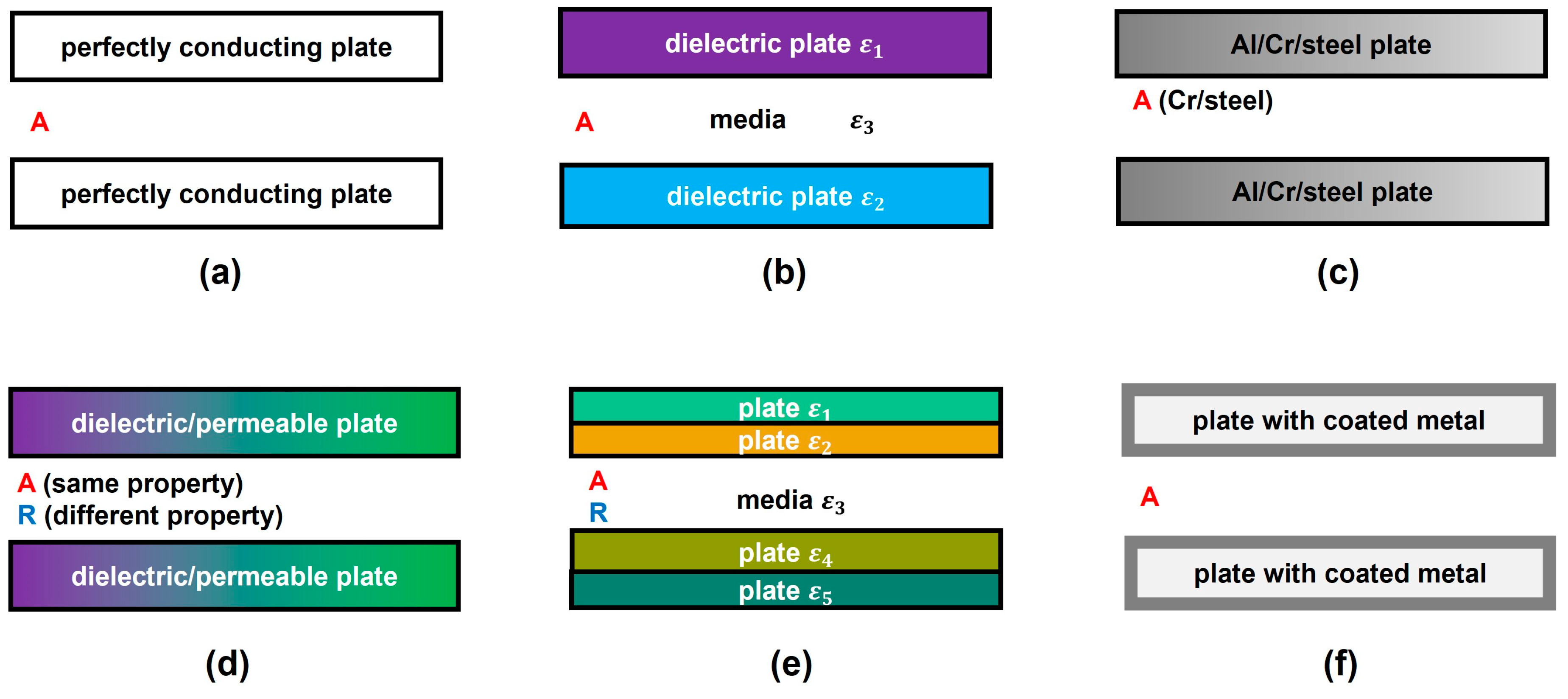
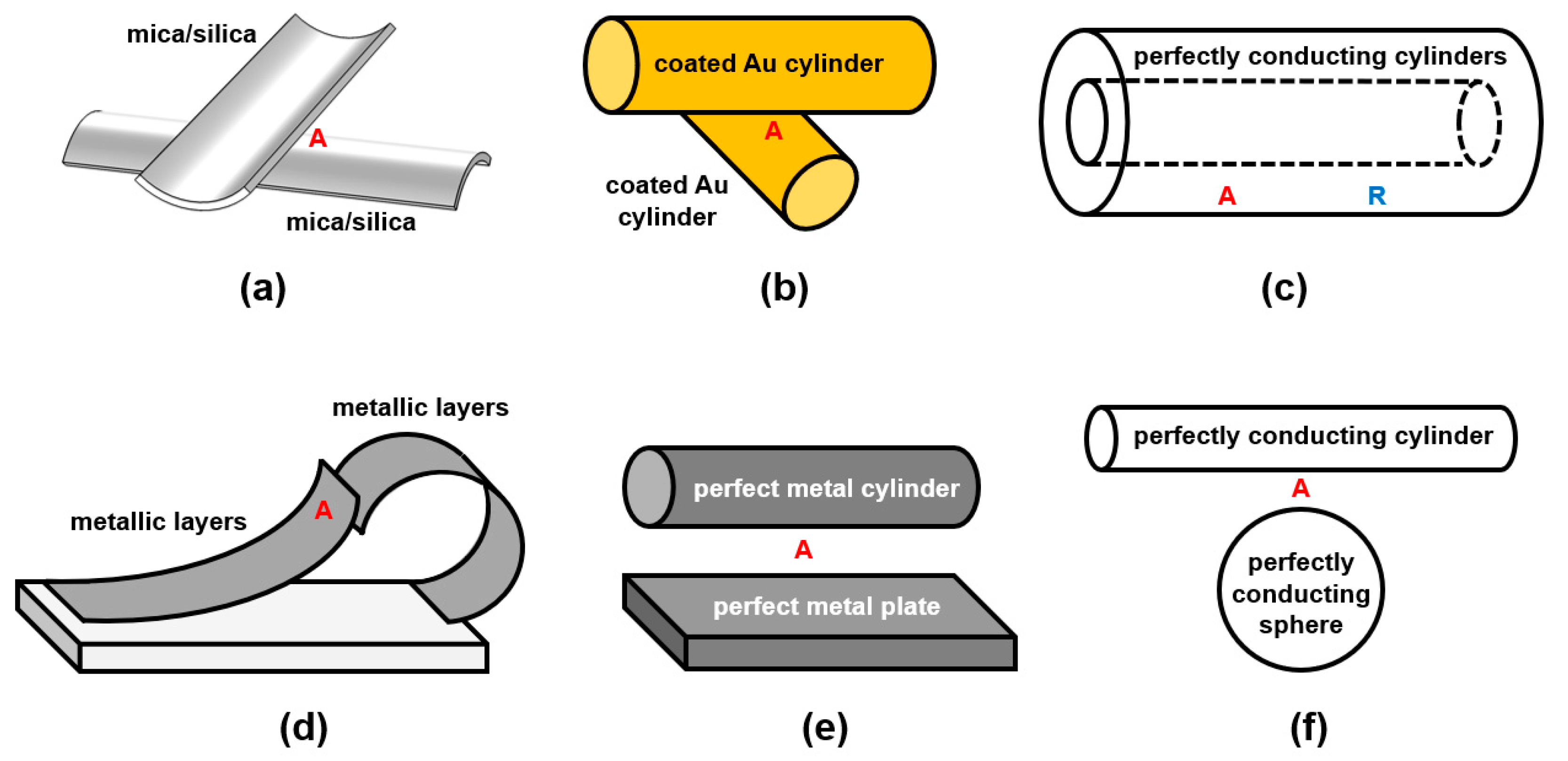
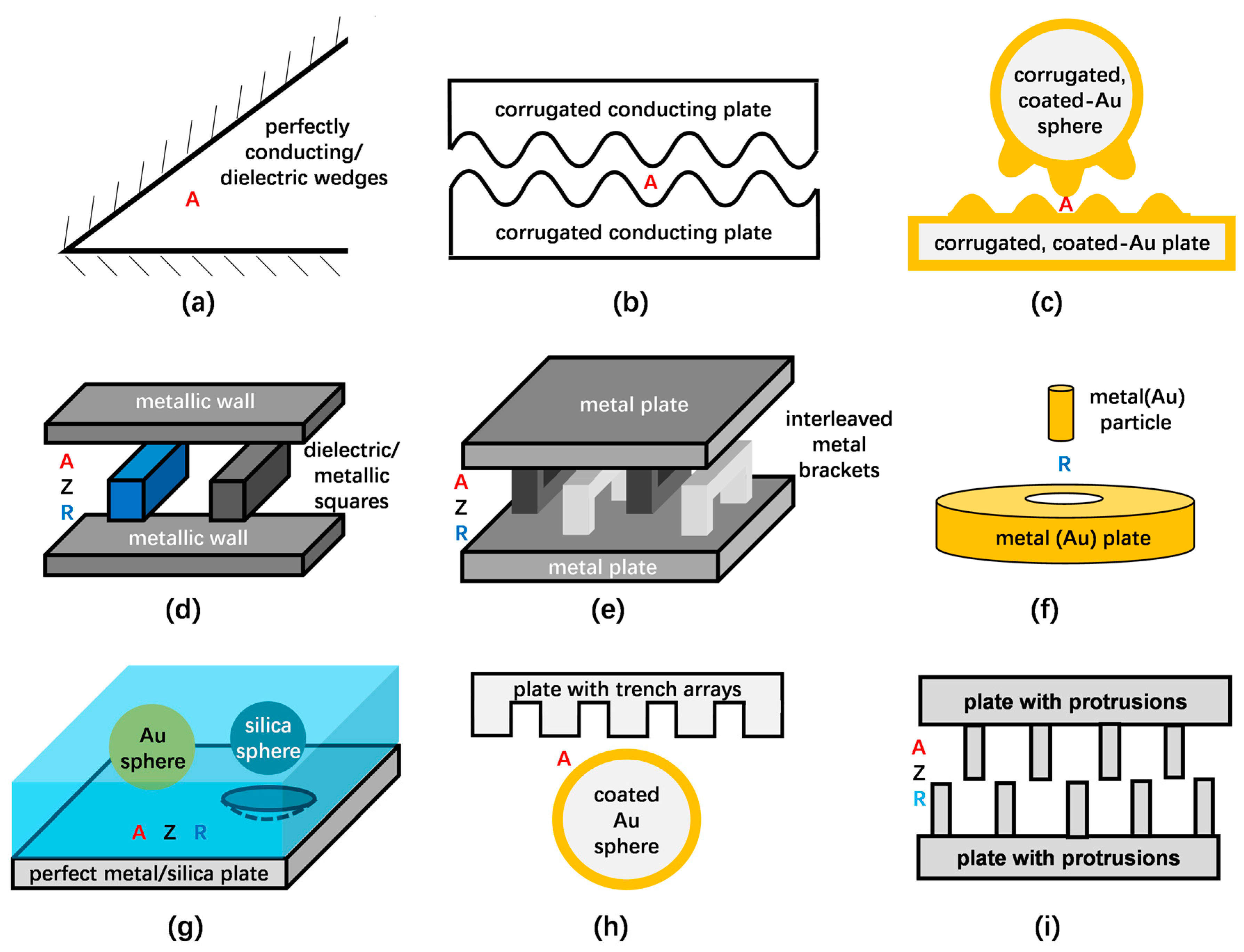
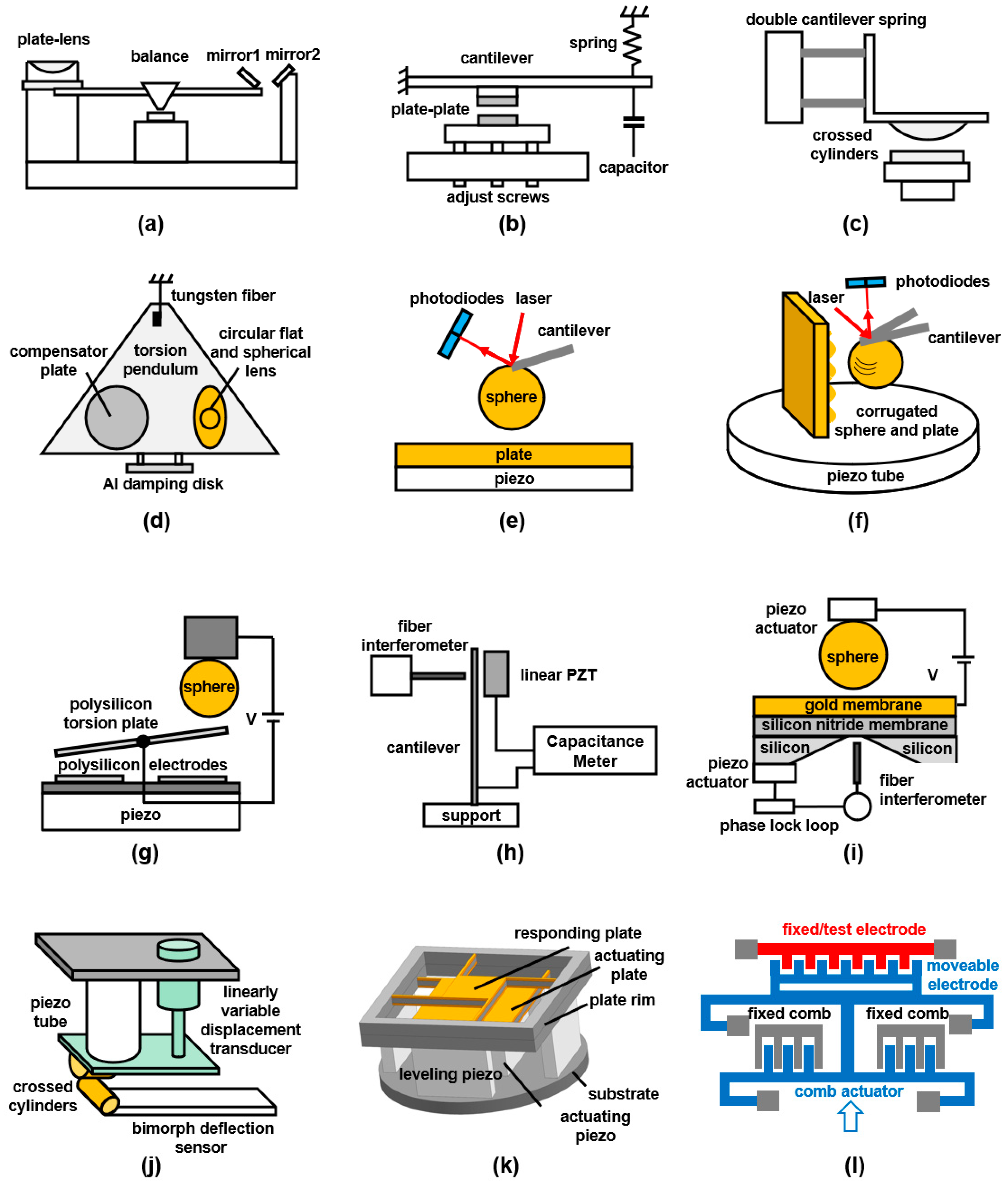

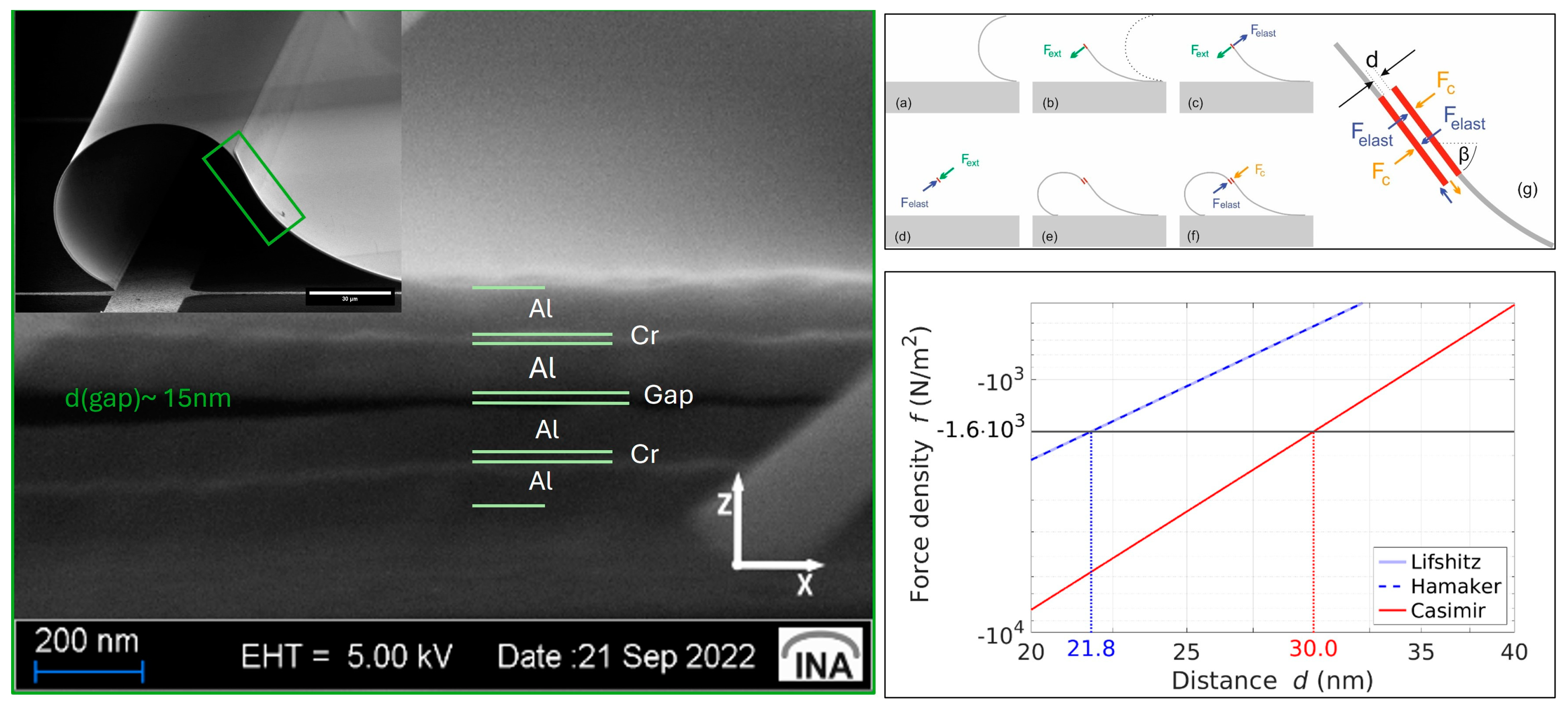


Disclaimer/Publisher’s Note: The statements, opinions and data contained in all publications are solely those of the individual author(s) and contributor(s) and not of MDPI and/or the editor(s). MDPI and/or the editor(s) disclaim responsibility for any injury to people or property resulting from any ideas, methods, instructions or products referred to in the content. |
© 2024 by the authors. Licensee MDPI, Basel, Switzerland. This article is an open access article distributed under the terms and conditions of the Creative Commons Attribution (CC BY) license (https://creativecommons.org/licenses/by/4.0/).
Share and Cite
Elsaka, B.; Yang, X.; Kästner, P.; Dingel, K.; Sick, B.; Lehmann, P.; Buhmann, S.Y.; Hillmer, H. Casimir Effect in MEMS: Materials, Geometries, and Metrologies—A Review. Materials 2024, 17, 3393. https://doi.org/10.3390/ma17143393
Elsaka B, Yang X, Kästner P, Dingel K, Sick B, Lehmann P, Buhmann SY, Hillmer H. Casimir Effect in MEMS: Materials, Geometries, and Metrologies—A Review. Materials. 2024; 17(14):3393. https://doi.org/10.3390/ma17143393
Chicago/Turabian StyleElsaka, Basma, Xiaohui Yang, Philipp Kästner, Kristina Dingel, Bernhard Sick, Peter Lehmann, Stefan Yoshi Buhmann, and Hartmut Hillmer. 2024. "Casimir Effect in MEMS: Materials, Geometries, and Metrologies—A Review" Materials 17, no. 14: 3393. https://doi.org/10.3390/ma17143393
APA StyleElsaka, B., Yang, X., Kästner, P., Dingel, K., Sick, B., Lehmann, P., Buhmann, S. Y., & Hillmer, H. (2024). Casimir Effect in MEMS: Materials, Geometries, and Metrologies—A Review. Materials, 17(14), 3393. https://doi.org/10.3390/ma17143393






